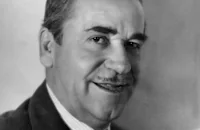The Four Feathers
Cast & Crew
Merian C. Cooper
Richard Arlen
Fay Wray
Clive Brook
William Powell
Theodore Von Eltz
Film Details
Technical Specs

Synopsis
Harry Faversham, a British regimental officer, fears the consequences of war. When his regiment is sent to active duty in the Sudan, he leaves the military service to marry Ethne Eustace. His companions, Durrance, Trench, and Castleton, learn he has actually resigned out of cowardice, and each sends him a white feather, symbolizing a disgrace that causes his father's death. Determined to redeem himself, he leaves England and becomes an African wanderer. Learning that Trench is imprisoned in a native fortress, he goes there but is himself captured; they are sold to a slave trader, but Harry kills him and they are pursued by tribesmen; a jungle fire and a herd of hippopotami prevent their escape across the Nile, but they are rescued by British soldiers in the Sudan, where Harry returns feathers to Durrance and Trench. The outpost is besieged by fuzzy-wuzzies, but a relief column under Castleton saves the British and Harry proves his bravery by killing the native chieftain.Later, the last feather is redeemed to Ethne, and the four comrades are decorated in England.

Cast

Richard Arlen

Fay Wray
Clive Brook

William Powell
Theodore Von Eltz

Noah Beery
Zack Williams
Noble Johnson
Harold Hightower
Philippe De Lacy
E. J. Radcliffe
George Fawcett
Augustin Symonds
Crew
Merian C. Cooper
Howard Estabrook
John Farrow
Julian Johnson
Robert Kurrle
Hope Loring
William Frederick Peters
Ernest B. Schoedsack
Ernest B. Schoedsack
David Selznick
Ivan Thomas

Film Details
Technical Specs

Articles
Fay Wray (1907-2004)
She was born Vina Fay Wray, in Cardston, Alberta, Canada on September 15, 1907. Her family relocated to Arizona when she was still a toddler so her father could find employment. When her parents divorced, her mother sent her to Hollywood when Fay's eldest sister died in the influenza epidemic of 1918. The reasoning was that Southern California offered a healthier climate for the young, frail Wray.
She attended Hollywood High School, where she took some classes in drama. After she graduated, she applied to the Hal Roach studio and was given a six-month contract where she appeared in two-reel Westerns (25 minutes in length), and played opposite Stan Laurel in his pre-Oliver Hardy days.
She landed her first big role, as Mitzi Schrammell, in Erich von Stroheim's beautifully mounted silent The Wedding March (1928). It made Wray a star. She then starred in some excellent films: The Four Feathers (1929), the early Gary Cooper Western The Texan (1930), and one of Ronald Coleman's first starring roles The Unholy Garden (1931), all of which were big hits of the day.
For whatever reason, Wray soon found herself in a string of thrillers that made her one of the great screamers in Hollywood history. The titles say it all: Doctor X, The Most Dangerous Game (both 1932), Mystery of the Wax Museum, The Vampire Bat (both 1933) and, of course her most famous role, that of Ann Darrow, who tempts cinema's most famous ape in the unforgettable King Kong (also 1933).
Wray did prove herself quite capable in genre outside of the horror game, the best of which were Shanghai Madness with Spencer Tracy; The Bowery (both 1933), a tough pre-Hays Code drama opposite George Raft; and the brutal Viva Villa (1934), with Wallace Beery about the famed Mexican bandit. Yet curiously, the quality of her scripts began to tank, and she eventually found herself acting in such mediocre fare as Come Out of the Pantry (1935), and They Met in a Taxi (1936).
With her roles becoming increasingly routine, the last of which was the forgettable comedy Not a Ladies Man (1942), she decided to trade acting for domesticity and married Robert Riskin, who won two Best Screenplay Oscars® for the Frank Capra comedies It Happened One Night (1934) and Mr. Deeds Goes to Town (1936). When Riskin died in 1955, Wray found herself working to keep busy and support her three children. She landed supporting parts for films like The Cobweb (1955), Hell on Frisco Bay (1956) and Tammy and the Bachelor (1957). She also found work in television on such popular programs as Perry Mason and Wagon Train before she retired from acting all together in the mid-'60s.
To her credit, Wray did remain reasonably active after her retirement. She published her autobiography, On The Other Hand in 1989 and was attending many film festivals that honored her contribution to film, most notably in January 2003, when, at 95 years of age, she accepted in person her "Legend in Film" Award at the Palm Beach International Film Festival. Wray is survived by a son, Robert Riskin Jr.; two daughters, Susan and Victoria; and two grandchildren.
by Michael T. Toole

Fay Wray (1907-2004)
Quotes
Trivia
Last U.S. mainstream silent movie (many hundreds of silent movies have been made since 1929, but not as mainstream releases by major US studios).
Notes
Filmed on locations in Africa, including the Egyptian Sudan.
















